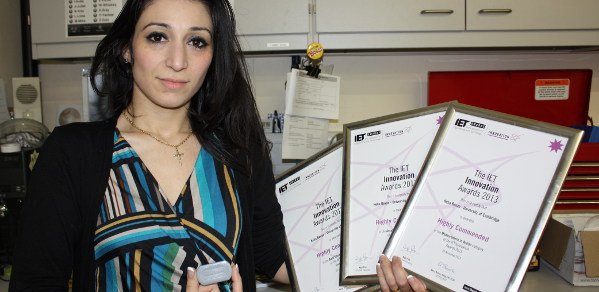
A new, unique and tiny sensor device named Utterberry, designed and developed at the Department of Engineering and deployed in the Centre for Smart Infrastructure and Construction's projects, could potentially transform infrastructure monitoring and possibly even act as a remote sensor for human health monitoring in the future.
The Utterberry has a number of attributes but the one which makes it stand out is its size. It’s about the size and weight of two £1 coins put together which means it compares favorably to current sensors which are around the size of a box of teabags and about as heavy as a bag of sugar.
PhD student Heba Bevan
“The Utterberry has the potential to become ubiquitous in the world of sensing,” says Professor Kenichi Soga, Professor of Civil Engineering. “It’s cute, clever and incredibly capable and has huge potential in sectors such as healthcare and building's monitoring."
The Utterberry is the work of PhD student Heba Bevan. Heba has been working with Professor Soga, to design and develop the wireless, low power sensor, which is capable of monitoring large scale assets such as tunnels and bridges.
“The Utterberry has a number of attributes”, says Heba “but the one which makes it stand out is its size. It’s about the size and weight of two £1 coins put together which means it compares favorably to current sensors which are around the size of a box of teabags and about as heavy as a bag of sugar.”
Sensors are used to monitor the health and safety of large infrastructure assets – such as buildings, bridges and tunnels. The small size of the Utterberry means it has practical and economic benefits when it comes to being deployed: “The fact it is so small and light means it is easy to carry as well as install and needs only one person to do this rather than a team of people” explains Heba.
It is also robust enough to withstand the elements of hazardous environments, home to many sensor devices: “I have tested the Utterberry in tunnels deep underground in London and also high on the Forth Bridge in Scotland. It is small but strong.”
The fact that the Utterberry was shortlisted and certified as ‘Highly Commended’ in three Institution for Engineering and Technology (IET) Innovation Awards - the Asset Management Award, the Built Environment Award and the Measurement In Action Award - is testament to its applicability.
“It has many other benefits,” continues Heba, “it uses almost no power – in fact it is approaching a zero power requirement – that’s as much as the fundamental laws of physics will allow!
"It’s actually like a miniature computer with its own network control software, making it clever and reliable.”
Powered by a microprocessor, the Utterberry is able to determine whether the wireless conditions are favourable or not and it is able to adapt its communication behavior accordingly.
Before undertaking her PhD Heba worked for ARM – one of the world’s technology leaders in mircoprocessors. “I was fortunate enough to be one of their central-processing-unit (CPU) designers and so what makes the Utterberry extra special to me is that I was one of the people who was involved in the design of the processor chip that’s inside my device as well!” says Heba.
Being wireless allows feedback data from the monitored asset to be accessed remotely by civil engineers rather than them having to be on site. “This makes both practical and economic sense,” explains Heba “as it avoids having to close down railway stations, for example, to install the sensors, as well as having to crawl around in tunnels beneath London or climb 200 feet above the Forth Suspension Bridge north of Edinburgh to get access to the data and monitor the condition of the asset in question.”
The potential of the Utterberry could take it beyond the realms of infrastructure application. One area Heba is keen to see it work in is the healthcare system. “I come from a family of medics and I wanted to design something that might also eventually help the medical profession and benefit society. These devices are so small and light, they could be easily clipped onto a piece of clothing, making it possible for a doctor to remotely monitor the health of a patient from home after a medical procedure.”
Heba is proud to have had her device recognised in this way by IET “I'm both delighted and excited that the Utterberry has been shortlisted as it demonstrates my technology means something - not just to me but to Industry at large. It is also important to me as there aren’t many women in the engineering world and I want to show young people out there and young women in particular that it is possible to be creative and clever – to think about neat solutions to problems and be able to achieve them – and I like to think the Utterberry brings a more feminine solution in what is still largely a man’s world.”
And finally, Heba explains why the name Utterberry: "‘Utter’ because in my opinion, it’s utterly perfect and ‘berry’ because it’s small like a berry and I hope that will sit alongside the other successful `technological fruits’ like Apple, Blackberry and Raspberry Pi in this techno-fuelled world”.

